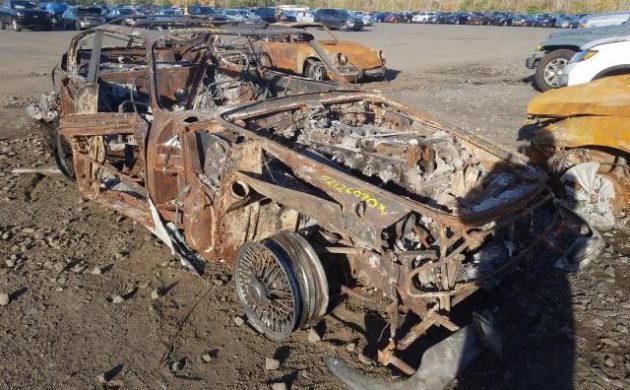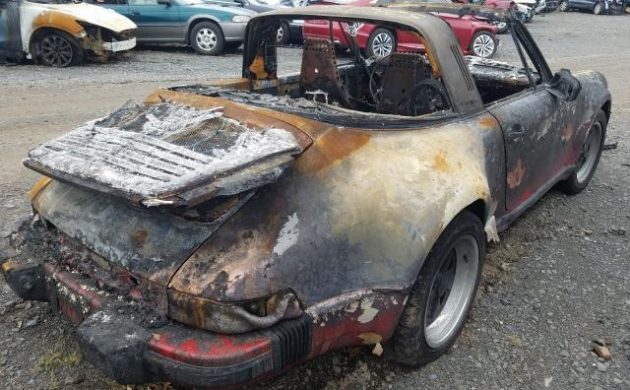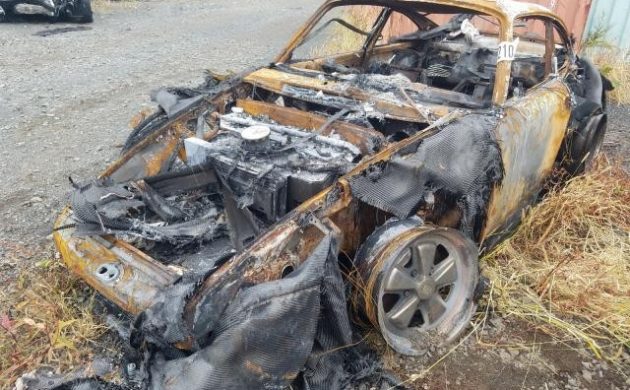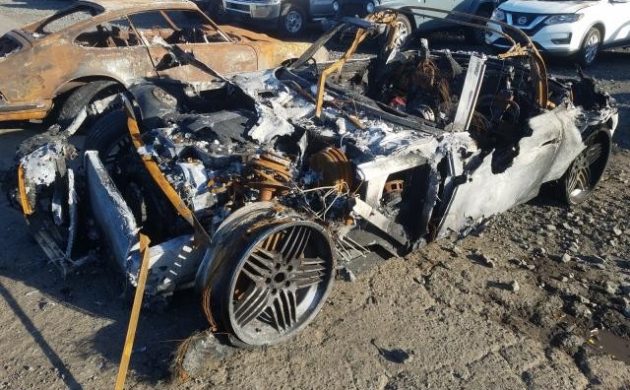This 1970 Aston Martin V8 Vantage is an obvious burn victim, with barely any recognizable details left beyond the classic wire wheels with knock-off hubs that managed to survive the blaze. The real story isn’t just a solitary vintage Aston Martin, however: peek over the roof line to spy a 911 in a similar, sad state and you begin to get a picture of the scale of the collection that was destroyed in a massive garage fire. The Aston Martin is listed here on Copart, and I have to ask: what do you do with a car like this? Is there anything left to salvage? Take a look at the other cars listed below and let us know in the comments if any of them can be restored.
The website The Drive actually sniffed out the full story beyond the wrecked Aston Martin that Barn Finds reader Desmond Gonzalez sent in. This is the one that gets me right in the feels, as it’s an exceedingly rare Porsche 911 Turbo Targa, believed to be one of less than 50 cars made in this configuration. Remember: Porsche sold the turbocharged 911 mostly in coupe form, with a few targas and convertibles sprinkled in. When you see those fat rear fenders, targa hoop, and whale tail, you know this 911 – listed here on Copart – is a major loss. Out of all the cars listed, this is the one I actually see as having the best chance at being reborn.
This is likely the car that made the owner – and the 911 community at large – cringe the most. Many of us know by now that Singer Vehicle Design has been snatching up 964-chassis 911s and converting them into top-shelf restomods that often take months to build and years of twiddling your thumbs while hoping your massive deposit actually yields you a car you can drive (by the way, you have these geniuses to thank for 964’s being priced well above their actual worth since they’ve stripped supply down to nothing.) Anyway, there’s one less Singer in the world, thanks to whatever explosion in the Hamptons caused this hedge fund manager’s colossal estate to burn to the ground.
Then there’s this, a 2000 BMW Z8, also listed here on Copart with the current bid of $200 likely hoping for a set of Alpina wheels to refurbish. Honestly, I don’t know how fire-damaged cars like these are of any use besides scrap, but I’m sure some enterprising salvage yard can figure out how to make $1.10 out of a $1.00 with a hulk like this. As The Drive article notes, there were several cars likely associated with this single property that have since been pulled from Copart, including a Ferrari 360 Modena and two air-cooled 911Ts. Can’t imagine what that insurance settlement looked like.






I sometimes wonder if someone isn’t just trying to be funny. What do you do when the temper is completely gone from the springs, and the steel has been reduced to mere tin? You’re better off baling it up and getting another one that’s complete. Fire is so final; it destroys everything in its path. I really feel sorry for the owner of these cars…
Really. Is it April Fools Day?
I hope the buyer doesn’t get burned🤣
Ran when parked.
I don’t see any Singer reference in the ad. As I understand their procedure, they replace the roof with carbon fiber. Not the case here??
Not all singer specs have a carbon roof. There arnt that many singers out there either so I’m not sure they can be blamed for the hike in prices and lack of stock around either.
Burn Finds?
Cube them, throw a piece of tempered glass on top of one and call it a conversation starter coffee table.
Car-amelized.
Did you mean “Car-melized?
Carmel is a city in Indiana. Caramel is cooked sugar. I think Scott had it right.
Car-melt-ised??
Does the value of the Turbo Targa support a recreation from the title up?
I know accidents happen, but I often wonder if the owners of these multi-million dollar collections spend any money (and/or how much) on fire protection/suppression for their storage areas? In my modest two car garage, I have approximately 8-10 fire extinguishers. Gasoline is stored outside in a separate area. Just a thought that pops up whenever I see the heartbreak of treasured car collections destroyed!
Several years ago I went with my car club to look at a collector’s collection of mostly muscle cars. About 50 cars, total worth well into the millions. They were in a modest metal building in a warehouse area. My eyes went to the ceiling, no fire suppression system. I asked the caretaker about it, and he just shrugged.
The value in cars such as these is the chassis number plate and paperwork.
A friend of mine had nearly finished the restoration of an SS Jaguar which was standing on jacks when a petrol bomb was thrown through the window setting it on fire. The heat was so tremendous that the aluminium engine and gearbox melted and the steel components fell onto the concrete floor, as did the generator, exhaust manifold etc. The rear leaf springs actually softened to the extent that they lost all strength and bent the wrong way, upside down, if you can visualize my description. It was on his fathers farm so no insurance. He was so disheartened by the whole event that he emigrated from South Africa to UK and never went back.
The only value lies in any official certificates denoting ownership, titles ETC. Otherwise only good for scrap metal.
Back when the Rolls-Royce Owner’s Club required ownership of a Rolls-Royce or Bentley automobile to become a member, [with serial number as proof], a very close friend of mine, without such a vehicle, asked me to give him the title & VIN plate to a 1930s R-R 20/25 limo I had parted out for my ’32, so he could join the club. All he wanted was the ability to get the club publications!
Sometimes a title & VIN do have extraneous uses!
Wrong Aston…but hope this helps: Not a ‘1970 V8 Vantage’ as quoted. For a start they didn’t exist until 1977, but it’s not even a V8 or a DBS either. Completely different model. It is in fact a DB6 MkII, and believe started life as one of only 46 AE Brico fuel-injected cars (from the 240 MkIIs built). A very rare David Brown era AM though, very sadly, no more.
from the looks of the remains, that was a pretty hot fire. When my house/garage burned, the primary heat fuel in the garage was 2 sets of magnesium wheels and 3 VW mag/alloy transaxles. Mag ignites at 830f but burns at 4000+f. yeah the fiberglass and all the other “stuff” (no gas or solvents were present) got it going, but once the cases caught it was over. On a kinda funny note – I had pulled the carpet out a car the night before in prep to steam clean it. I tossed it over a third set of LeGrand wheels. With just the insulation from the carpet, even tho the carpet burned it was enough to keep the wheels from igniting.
Hey Bill, Could you explain what a not-so-hot fire, is like??
Stan – a “not so hot” fire is your “typical” house fire. Burns in the 1,100 to 1,500 degree range depending on fuels (whats there to burn). A forest fire can burn in the 2,000 degree range. A fire fueled by highly combustibles (such as magnesium) will burn north of 4,000 degrees.
That’s good to know, Bill. I’m aware all fires are hot. Now I know to what degree.
Thanks buddy
I had a customer with a building full of Packards. Some kids torched the building. I worked on a few 0fmthe cars afterwards, but I honestly feel that he was wasting his money. Sad.
I know a few yacht owners, who are in need of boat anchors.
I wonder which Singer commission it is. The Singer web site shows each of them. They are spectacular builds. The 4.0 motor option is really a work of art, but each of these $500,000 plus cars deserve a place in a gallery.
http://singervehicledesign.com/works/
As I have said in other posts here on Barn Finds, When a car is destroyed to this extent, from a safety point alone, NONE of the steel or iron parts are suitable for restoration or rebuilding, unless the original metallurgical specifications can be met once again thru the proper tempering process.
Every piece of steel used in an automobile has a specific grade of temper when it is manufactured. Because a car or building fire is slowly allowed to cool down, there is ZERO temper left in the part.
I have been the victim of not one, but 2, lightning-induced building fires that resulted in the total loss of over 30 vehicles. [There have been a few people, on hearing this, who were a bit nervous being around me!]
I have experienced first hand just what a high-heat fire does to an automobile. I’ve been able to take engine parts off without tools, because the bolts & nuts were finger tight [before rust set in of course].
I’ve had forged steel parts break into multiple pieces when dropped 4′ onto hard concrete, because they were now brittle. Would YOU want to use a set of forged steering spindles or other suspension parts that have been thru such a fire? How about a cast iron steering box with forged worm & roller parts inside?
I had a 1956 Packard with the 2X4 carb setup fully burn, to the point the carb metal melted & pooled in the intake manifold passages. Once removed from the engine, [and remember, the manifold was bolted firmly on the heads] was so badly warped it would rock from opposite corner to corner on a flat steel workbench.
Ask ANY mechanical engineer if he would attempt to repair or restore a vehicle [or even one part] after it was severely burned in a fire. I can promise his answer would be a resounding NO!
I watched as an all original 1938 Alfa Romeo 6C2500 coupe burned right next to a V8 Packard Caribbean convertible, next to the only 1956 Packard Caribbean 4-door sedan ever built. All were total losses, and I would never have even considered trying to salvage them.
Great posting Bill.
Further proof that the main reason these piles of molten junk are offered up for sale is the knowledge that there is money to be made in the fraudulent practices of the car hobby. When was the last time someone published an article where the buyer ( maybe there aren’t any) of this junk actually retained possession of it, whether it be in parts or rebuilt form?
having gone through 2 wildfires I can tell you there isn’t anything left to salvage when something burns that hot…dreaming is what they are doing…
Fires like this are reminders to everyone: Insure your stuff! There are companies that specialize in agreed value insurance for specialty cars, restorations, hot rods, even racing cars (not on track). You can buy HPDE insurance at agreed value. Heck, I’ve watched a friend buy this insurance on the spot via his phone at a track on a Friday evening after he learned such a thing existed.
This insurance can extend to your trailer, your tools and equipment inside the trailer, the works. Do not think to yourself, “oh my home owners covers my cars and tools” or “car car/truck insurance covers my trailer, the car inside and tools/equipment”. I can promise you from experience it does not in any meaningful way.
I do not work in insurance, I am just a guy who has taken a deep dive into this subject and witnessed far too many friends and people within the car hobby/motorsports loose everything to fire, theft etc without insurance. It is far cheaper than you think.
Bryan – thanks for the reminder. When our house/garage fire happened, I was under the impression that what I had was covered. What I found out was that even though the parts/vehicles were off the road (or not meant for the road) they were NOT covered. PLUS…found out that my tools were not covered either. They wouldn’t cover anything over what would be “reasonable and customary” for the home garage.
Our uninsured losses were just over $492,000.
Bryan, you don’t have to work in insurance, to know your car ins. policy is separate from your homeowners policy. The advantage of using the same ins. co., for both, allows you to get a discount.
I don’t work in the ins. biz. I only play one on TV. LOL!!